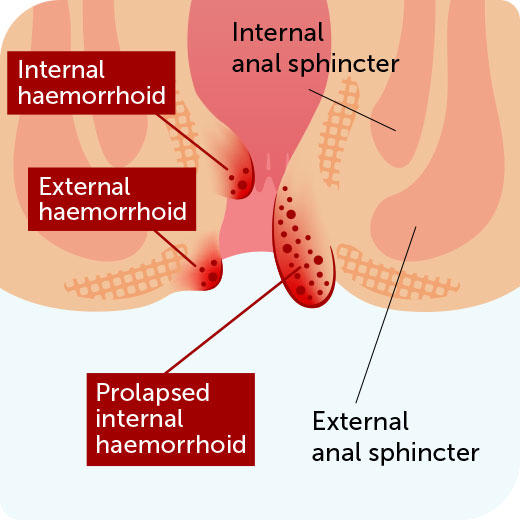A guide to external haemorrhoids: from symptoms to treatments
If you’ve ever seen or felt a small lump around your bottom after visiting the toilet, it could be what’s known as an external haemorrhoid.
Haemorrhoids, or piles, are swollen and inflamed veins found in and around your bottom and lower rectum (the section of the large intestine that connects your colon to your anus).
Depending on where they're found, they can be described as either internal or external. External haemorrhoids form under the skin around the anus, whereas internal haemorrhoids form in the lining of the anus itself.
While external haemorrhoids will often get better on their own after a few days, they can sometimes be itchy and uncomfortable to deal with. External haemorrhoids can also be very sensitive and painful, as they occur close to the skin, which contains pain-detecting nerve endings.
If you want to learn more about what external haemorrhoids are, what they’re caused by and what you can do to prevent them, read on to find out.
What do external haemorrhoids look and feel like?
To check whether you’ve got an external haemorrhoid, it’s important to understand what you’re looking for.
Unlike internal haemorrhoids, which you can’t see, external haemorrhoids will appear as a small lump or bump in any place under the skin around your bottom. They also develop in the lower third of your anal canal (closest to your anus).
Once formed, external haemorrhoids are covered by a modified tissue (known as anoderm) with a high density of nerve endings able to detect pain. So, unlike internal haemorrhoids, which are normally relatively painless, external haemorrhoids can sometimes feel very painful.
They can also cause various other symptoms, including:
- An itchy bottom
- The appearance of one or more hard, tender lumps near your bottom
- Anal ache or pain (especially when sitting down)
External haemorrhoids can vary in both size and colour, ranging from anywhere between the size of a pea and a grape. They’ll also usually be either pink or purple in colour.

What causes external haemorrhoids?
We now know what an external haemorrhoid looks like, but why do we get them?
Both external and internal haemorrhoids tend to happen when there’s too much pressure on the veins located around your bottom. However, it’s not clear what exactly causes this.
Some things that make external haemorrhoids more likely include:
- Constipation
- Pushing too hard when pooing
- Heavy lifting
- Having a chronic cough
- Maintaining a low-fibre diet
External haemorrhoids can also be brought on as a result of the tissues in your bottom and rectum weakening due to age or conditions that increase the pressure inside your abdomen, such as pregnancy or giving birth (but more on this later!).
Are there any complications associated with external haemorrhoids?
While most cases of haemorrhoids will often get better on their own after a few days, they can sometimes develop into further issues, including various anal conditions and the potential development of what’s known as a thrombosed haemorrhoid.
However, these can usually be treated using medication or specific surgical and non-surgical procedures. Your doctor will be able to advise you on the best treatment for your needs, so speak to them if you’re concerned and would like to receive tailored support.
External haemorrhoids during pregnancy
If you’re pregnant, the hormonal changes you go through and the growing pressure inside your abdomen may cause you to experience external haemorrhoids more frequently.
The actual process of giving birth can also increase your risk of developing haemorrhoids due to the pressure put on your abdomen from pushing the baby out. So it’s important to talk to your doctor for personalised advice on how to deal with haemorrhoids while you’re pregnant.
How are external haemorrhoids treated?
Whether through making certain lifestyle changes or taking specific medications, there are several ways to ease some of the symptoms of external haemorrhoids when they start to appear.
Let’s start by looking at some of the treatments you can use from the comfort of your own home.
At-home external haemorrhoid treatments
If you think you might have an external haemorrhoid, you can often treat it at home by making a few changes to your lifestyle and diet.
You could try the following tips to help ease your symptoms
- Having a warm bath
- Wrapping an ice pack in a towel before applying it to the painful area
- Wiping your bottom softly with damp toilet paper
- Keeping your bottom clean and dry
You should also aim to drink plenty of fluids, as this can make your stools easier to pass and reduce how much you need to strain during bathroom visits.
It’s important to include fibre-rich foods in your diet as well, as these can help encourage more regular bowel movements, prevent constipation and reduce bleeding. Consider adding foods such as wholegrain bread, beans, pulses, nuts, chickpeas, seeds and dried fruits into your diet.
It can also be beneficial to try and cut down on caffeine and alcohol. Caffeine has been shown to dehydrate the body and worsen constipation, for instance, whereas alcohol can irritate your gut.
You can also use various over-the-counter medications to help combat your symptoms, such as Germoloids® Cream or Germoloids Ointment. They contain an anaesthetic, so applying them directly onto your external haemorrhoid may help to provide symptomatic relief of the pain, swelling, irritation and itching often associated with external haemorrhoids.
You can pick these up from your local pharmacy, where your pharmacist will be able to advise you on which type of treatment is best for your needs.
External haemorrhoid treatment from medical professionals
If you find that making lifestyle and dietary changes aren’t making much difference, or that over-the-counter medications aren’t helping your symptoms, seek advice from your doctor.
After asking you about your medical history and performing a physical exam, they’ll be able to diagnose your external haemorrhoids and advise you on which treatment is best for your needs.
For further information on what haemorrhoids are, including their symptoms and causes, head on over to our tips and advice page or discover some of our other great articles below.







